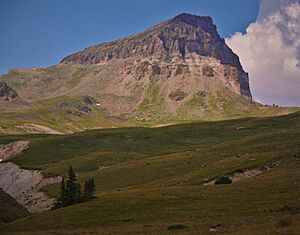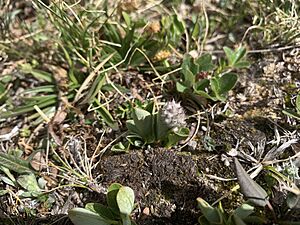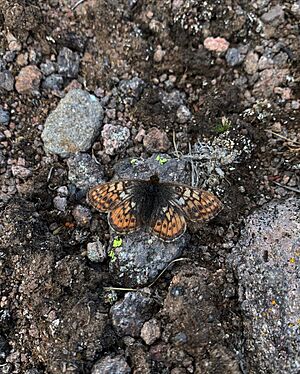Uncompahgre fritillary facts for kids
Quick facts for kids Boloria improba acrocnema |
|
|---|---|
 |
|
| Conservation status | |
| Scientific classification |
|
| Kingdom: | Animalia |
| Phylum: | Arthropoda |
| Class: | Insecta |
| Order: | Lepidoptera |
| Family: | Nymphalidae |
| Genus: | Boloria |
| Species: |
B. improba
|
| Subspecies: |
B. i. acrocnema
|
| Trinomial name | |
| Boloria improba acrocnema Gall & Sperling, 1980
|
|
The Uncompahgre fritillary butterfly (Boloria improba acrocnema) is a special type of butterfly. It belongs to the Lepidoptera order, which includes all butterflies and moths. This small butterfly is found only in Colorado, USA.
Scientists first discovered this butterfly in the summer of 1978. At first, they thought it was a subspecies of another butterfly called the dingy fritillary. But later, more studies showed it was unique enough to be its own full species!
Contents
Where This Butterfly Lives
The Uncompahgre fritillary was first found high up on Uncompahgre Peak. This mountain is in Hinsdale County, Colorado, USA. A group of scientists discovered it while working near the Rocky Mountain Biological Laboratory. A few years later, another group of these butterflies was found. They were living on Redcloud Peak, which is about 10 miles south.
This butterfly lives only in a small area of southwestern Colorado. This includes parts of the northern San Juan Mountains and the southern Sawatch Range. It has one of the smallest known homes of all North American butterflies. Since its discovery, small groups of Uncompahgre fritillaries have been found in 9 other spots. Scientists check on these groups every year.
Its closest butterfly relative lives far away in Wyoming. Other butterflies that look similar also live in these mountain areas. These include the Varied checkerspot and the Arctic fritillary. The Uncompahgre fritillary lives in very high places. These are called alpine tundra environments. They are usually 3800 to 4200 meters (about 12,500 to 13,800 feet) above sea level. These areas are cool, moist meadows that face northeast. They get most of their water from winter snow and summer rain.
Its Favorite Plant
The Uncompahgre fritillary butterfly is very picky about its food. Its caterpillars only eat one type of plant! This plant is called snow willow (Salix reticulata spp. nivalis). It is a small, dwarf willow plant. You can find these butterflies only where patches of snow willow grow.
Life Cycle of the Butterfly
Female butterflies lay their eggs one by one. They place them on the stems and leaves of the snow willow plant. This usually happens around the middle of July. The eggs are tan and hatch several weeks later.
Once hatched, the tiny caterpillars eat snow willow leaves. They live for two years as caterpillars. They spend the winter hidden under the snow. In the spring, they come out and grow bigger.
Adult butterflies are small. They have fuzzy, dark brown or black bodies. Their antennae are also dark. Females have slightly lighter wings than males. Their wingspan is about 1 inch wide. The wings are colorful, with patterns of tan, orange, brown, and black. They also have a unique triangular shape on their wings.
Adult Uncompahgre fritillaries only fly for a few weeks in the summer. They appear after the snow melts in their high mountain homes. You can see them flying from late June to early July. They are not strong fliers. They need full sunlight and very little wind to fly. These butterflies tend to stay close to where they were born.
Protecting the Butterfly
Why It's Endangered
Scientists used special methods to count these butterflies. They found very few butterflies at Uncompahgre Peak and Redcloud Peak. People thought the Uncompahgre fritillary was almost gone. So, in 1991, it was put on the Endangered Species List.
Since then, more groups of these butterflies have been found. But the numbers are still very small. This means they are not yet safe enough to be removed from the list. Scientists worry about several things that could harm them. These include animals eating their plants, people illegally collecting them, and outdoor activities. Climate change is also a big worry. It could make their mountain homes too warm or too dry. Another concern is that the different butterfly groups might not have enough genetic differences. This could make them weaker.
Climate change is a big threat to these butterflies and their mountain homes. Alpine areas are some of the coldest places where insects can live. But the plants and animals in these places might not be able to handle changes in temperature and rain.
Helping the Butterfly Survive
The Uncompahgre fritillary butterfly is still listed as endangered. The U.S. Fish and Wildlife Service has a plan to help it. This plan focuses on understanding why their numbers are so low. It also aims to stop them from disappearing forever.
Government groups like the Bureau of Land Management and the U.S. Forest Service watch these butterflies every year. They check the numbers at Uncompahgre Peak and Redcloud Peak. They also learn more about where the butterflies live. These groups have taken steps to help. They have stopped animals from grazing on certain slopes. They have also moved hiking trails and put up signs. These signs tell hikers about the butterfly's endangered status.
The Uncompahgre fritillary needs a very specific home. It also lives in a very small area. This makes it a good indicator of how climate change might affect mountain ecosystems. Efforts to protect this butterfly continue. They aim to stop illegal collection and keep an eye on their numbers. They also check the quality of their home and any environmental problems they might face.
See also
- List of butterflies of North America





